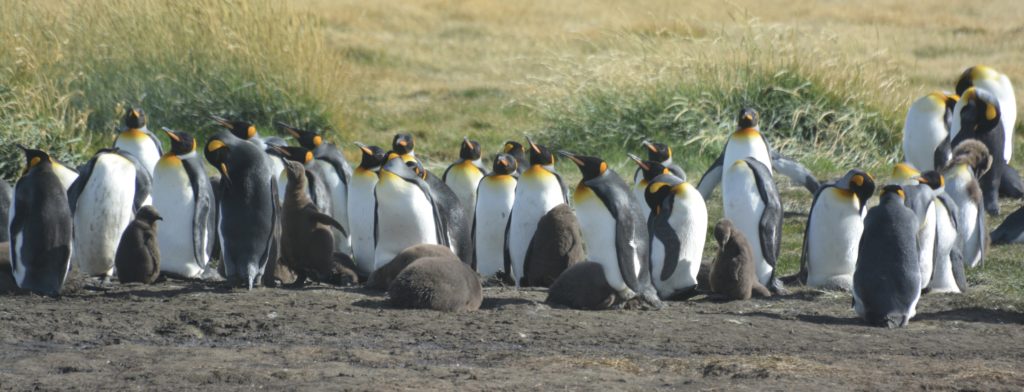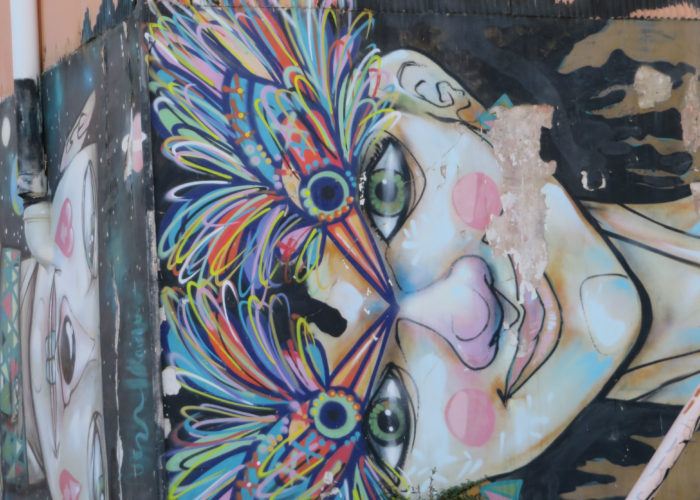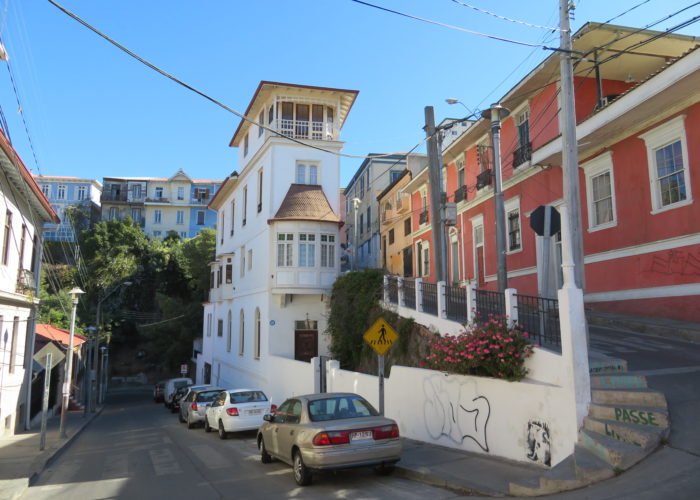Chile is geographically one of the most unusual countries in the world stretching some 4,300 kilometres in the tropics on the border with Peru and Bolivia to the far south of the continent in the almost arctic Cape Horn and Tierra del Fuego. Its average width is just 175 kms and the Andes Mountains that form the border with Argentina. The physical border that the Andes to the East and the Atacama Desert in the North means that Chile is geographically separate from the rest of South America. Crossing the Chilean land borders is a much more lengthy experience that others on the continent as the authorities check all agricultural products to protect their local industry from insects or other invasive species.
Economically Chile is a relative success story by South American standards, and today Chile is a member of the rich mans club the OECD. In the past Chile was much poorer than neighbouring Argentina, but now it’s a very different story and many Chileans are very proud of that fact. Politically Chile still has many divisions, and in particular there are very contrasting views about the Pinochet dictatorship and whether is brutality was an acceptable price to pay for the relative economic success it brought in.
The large urban cities of Santiago de Chile, Valparaiso etc. and very modern cities with a large number of young people and are pretty typical of similar large metropolitan cities in South America and the world. The Chilean countryside however, is much more conservative.
The Chilean authorities and population in Patagonia take immense care and pride in protecting the unique fragile environments there, and in places like Torres del Paine there is some of the best trekking and unspoilt mountain scenery in the whole world. The W Walk to the towers of Torres del Paine is one of the great treks in the world and well worth the effort of getting to.
In the north of Chile is the Atacama Desert, where it has hardly rained for many years. The climate is harsh but the scenery is some of the most spectacular in the continent. In addition with the almost complete lack of cloud cover, the night skies in the Atacama are probably some of the clearest in the world.
Destinations

- Torres del Paine
- Tierra del Fuego
- Pucón
- Santiago de Chile
- Valparaiso
- Viña del Mar
- San Pedro de Atacama
- Torres del Paine

The Parque Nacional Torres del Paine is one of the top destinations in all of South America and well worth the effort of getting there. It is situated at the southern end of the main South American continental land mass and many of the mountains come straight down to the sea. In the centre of the park are the three towers, Paine Towers, that sit as an iconic back drop to the glacial corrie lake and surrounding glaciers. There are many other high peaks in the park together with several picture postcard glacial lakes which reflect the surrounding mountains, none more so than Lago Nordenskjöld.
There is a classic trek that starts from Lago Pehoe and follows a large W shape through to Glacier Grey, and then on to the middle of the W at Britanico with views of Cerro Fortaleza and then finally along the shores of Lago Nordenskjöld and up to the Chilean refuge and the lake at the bottom of the three towers.
The circuit takes three full days and you will need to arrange permits to do the walk. The permits are there to help manage the numbers and also a number of the passes involve some intense scrambling so the guides accompanying you are important for safety. Campsites are set up across the route and also provide healthy food.
2. Tierra del Fuego

Chile shares Tierra del Fuego with Argentina, the border is simply a straight line down the middle of the island though Chile has the main access point where the ferry crosses the Magellan Strait, but Argentina has the main settlement in Ushuaia.
Tierra del Fuego at the foot of South America is often called the end of the world and still feels a bit like it, being very isolated and experiencing huge winds and a barren landscape. Many of the famous explorers went to Tierra del Fuego and navigated either the Beagle Channel or the Magellan Strait to cross form the Atlantic to the Pacific Oceans and avoiding the extremely dangerous Southern Ocean.
The landscape has a natural beauty and the light reflecting off both the snow capped mountains and the waters makes for a dramatic site. The human history in addition to the explorers also reflects both the harshness of the environment and its remoteness.
On the southern coast on the Chilean side of the island is one of the few colonies of king penguins outside of Antarctica and observing these elegant colourful penguins is one of the highlights of any visit.
3. Pucon

Pucón is the principal resort town in the Chilean Lake District. The town is dominated by the active volcano, Villarrica, which offers some fantastic views of the surrounding lakes and mountains. Villarrica is still very active and climbing the summit requires careful management and equipment, including crampons and gas masks. The Chilean authorities closely monitor all seismic activity and if there is any danger of eruption or extensive gasses they will immediately close the mountain. Getting to the summit involves taking a rickety chair lift and then a carefully zig zag up the mountain, using cramps and ice picks. The summit bears the scares of sulphur and other volcanic materials.
The descent down the volcano often involves tobogganing down the mountain on your back, a quite exhilarating experience. Pucón town is a typical Alpine resort town with wood cabins and a number of bars and restaurants.
4. Santiago de Chile

Chile’s capital, Santiago, sits in a bowl surrounded by mountains on all sides and has one of the most pleasant backdrops of all cities. Some of the surrounding mountains are snow capped, which adds to the dramatic location. However the city has grown enormously and numbers a population of around seven million, which when one considers that Chile’s total population is 18 million, the city dominates the country. With such a large population coupled with significant development in recent years, the number of motor cars and industrial activity has created a significant amount of pollution, which often gets trapped in the bowl that Santiago resides in.
The city centre around Plaza de Armas has many grand colonial buildings, while the rest of the city has many glass clad skyscrapers. With Santiago in the area of intense seismic activity the local building regulations are very strict. During our short stay we experienced an earthquake measuring 6.1 which shook the buildings – our apartment was on the 19th floor. However while 6.1 is technically a large earthquake, with excellent building regulations, most Chileans would not get out of bed for such an earthquake.
Santiago has a large student population, with many young people from all over the country being attracted to the universities in Santiago. This gives the city a dynamic vibe with many bars, clubs and restaurants all over the central barrios.
Within the city boundaries is Cerro San Cristóbal, which can be reached by funicular and on a clear day offers some stunning views of the city and the surrounding mountains. Many of the local Santiago population will go up the peak on weekends and picnic there while also taking in the religious sanctuaries and buildings there. Chile is probably one of the most devoutly religious countries in all of South America.
5. Valparaiso

Valparaíso is probably Chile’s most interesting city perched on the cliffs and mountainside above the port. Valparaíso has many painted colonial buildings hugging the hillside and also some of the best street art in South America. There are a number of old funiculars that climb the hillsides and visitors to explore the many attractively restored colonial buildings and the street art.
The city can feel a bit edgy at night, but with sensible precautions and avoiding certain areas it is a great place to spend a few days. Further up the coast is the resort town of Viña del Mar, which is much more modern than Valparaíso and has a number of large sandy beaches which fill up in the summer season.
6. San Pedro de Atacama

The small oasis town of San Pedro de Atacama functions as a convenient base to explore the surrounding desert and countryside. San Pedro is very much a gringo town almost totally set up to support the tourist trade and as a result has many bars, restaurants and hostels.
The real draw of San Pedro are the trips out to the many distinctive landscapes, including the Valle de la Luna, Garganta del Diablo and the Valle de la Muetre. Many of these sites allow one to imagine what life would be like on a different planet.
The Atacama receives hardly any rainfall, being one of the if not the driest places on Earth. The almost total absence of cloud cover, makes the night sky, with clear views of all the stars and planets another big draw.
Blogs
- http://highburynomad.com/torres-del-paine-the-w-walk/
- http://highburynomad.com/tierra-del-fuego-the-end-of-the-world/
- http://highburynomad.com/in-patagonia/
- http://highburynomad.com/pucon-smoking-volcano/
- http://highburynomad.com/santiago-de-chile-centre-of-chile/
- http://highburynomad.com/santiago-de-chile-final-thoughts/
- http://highburynomad.com/valparaiso-funiculars-and-street-art/
- http://highburynomad.com/san-pedro-de-atacama-oasis-in-the-worlds-driest-desert/
Slideshow
Travel
Chile like Argentina has an efficient transport network, with modern multi lanes highways connection the principal cities especially in and around the vicinity of Santiago de Chile. The intercity bus network connects all major cities with modern busses with large comfortable seats and host/hostess service between large bus terminals, which are similar to modern railway stations in Europe etc. Booking international buses requires a bit more planning, as while there are frequent busses between Santiago de Chile, Valparaiso to and from Mendoza and other towns in Argentina, there are much less frequent buses to San Pedro de Atacama as these tend to solely cater for tourists as opposed to the much wider connections Central Chile has with Argentina
Santiago de Chile has a top up card system that covers busses, urban trains etc. that make travel around the city very easy and efficient.
Roads in Patagonia, the Atacama and more remote areas are less developed, though the amount of traffic is not great. Some roads in the mountain areas can be unpaved, but as rule travel anywhere in Chile is relatively comfortable. The far South of Chilean Patagonia can only be accessed by road by crossing into Argentina. Often travel in Southern Chile and Argentina involves frequent border crossings and in particular entry back into Chile can be time consuming as the authorities check for agricultural products. Do not take any fresh fruit or loose nuts across the border into Chile.
Some of the distances can be huge and in particular in parts of Patagonia you can travel for whole days without coming across any major settlements. Air travel is probably a sensible option if time is short.
For our journey around Patagonia we chose dragoman.com Patagonia and Beyond ZSB journey from Buenos Aires to Santiago. Overland companies like Dragoman have the advantage of flexibility that not only can take you to many inaccessible National Parks by public transport, but also have the advantage of being able to stop at view points on the way which intercity busses will simply pass through.
Costs
Chile is one of the more expensive countries in South America as it has for a number of years been relatively successful economically. Drawing cash out from the ATMs can be an expensive business, for while rates charged locally are not up to Argentinian standards, at 3.25% on average, which together with the fees charged by your home bank, makes it sensible to consider alternatives to cash drawn out from ATMs. Credit cards are widely accepted and can be a cheaper option for accommodation and trips than cash when considering the all round costs.
As with elsewhere in South America, the USD is king and widely accepted. However you need to be careful with any USD notes that are less than pristine, as combos etc will often reject notes so you may often have to take any old notes back home to either use or change.
Chile produces a lot of high quality agricultural produce and shopping in the markets and supermarkets is often great value. Chile has a full range of restaurants and fast food joints across all price ranges so visitors can eat very well in Chile.
Accommodation
Places we Stayed
- Torres del Paine: Camping Pehoe
- Tierra del Fuego: Bush Camping
- Pucon: Hostal Victor
- Santiago de Chile: Happy House Hostel
- Santiago de Chile: Air BNB
- Valparaiso: Ibis Valparaiso
- San Pedro de Atacama: Quecha Hotel



























